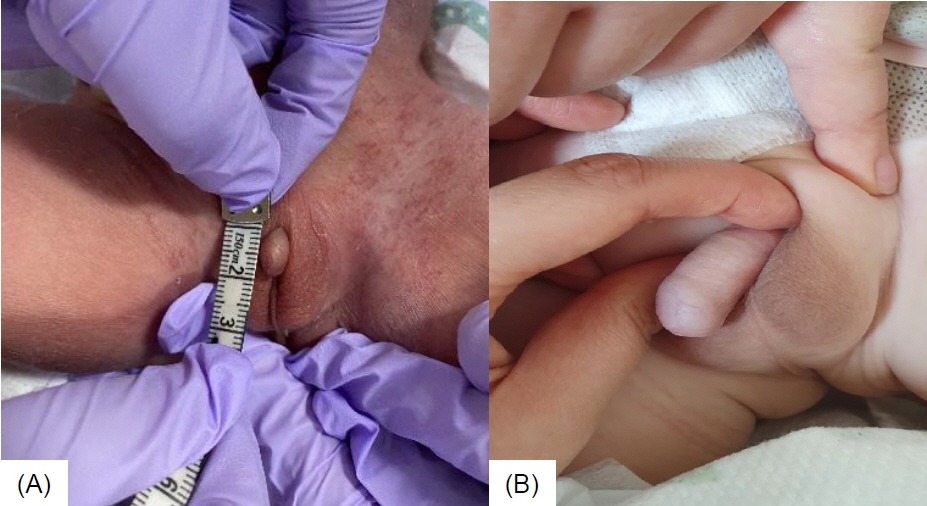Ann Pediatr Endocrinol Metab.
2023 Dec;28(4):308-311. 10.6065/apem.2244174.087.
A Korean male with Kleefstra syndrome presented with micropenis
- Affiliations
-
- 1Department of Pediatrics, School of Medicine, Kyungpook National University, Kyungpook National University Hospital, Daegu, Korea
- KMID: 2549325
- DOI: http://doi.org/10.6065/apem.2244174.087
Abstract
- Kleefstra syndrome is caused by chromosome 9q34.3 deletion or heterozygous mutations in the euchromatin histone methyl transferase 1 (EHMT1) gene. It can be accompanied by intellectual disability, distinctive facial features, microcephaly, psychiatric disorders, hypotonia in childhood, hearing loss, heart defects, renal defects, epilepsy, speech anomalies, and obesity. Furthermore, genital anomalies are present in 30%–40% of male patients with Kleefstra syndrome, but their mechanisms have not been elucidated. Herein, we report a patient with Kleefstra syndrome presenting with micropenis. The patient was transferred to Kyungpook National University Children's Hospital for management of imperforate anus on the day of birth. Physical examination revealed micropenis with stretched penile length of 0.9 cm and facial dysmorphisms, including hypertelorism and anteverted nares. Chromosomal microarray revealed 424-kb heterozygous deletion at chromosome 9q34.3 (arr[hg19] 9q34.3 (140,234,315-140,659,055)x1). Among the involved main OMIM genes, phenotypically relevant genes were EHMT1 and NSMF. Endocrinological investigation showed low basal gonadotropin and testosterone levels. Anterior pituitary hormones and steroid hormone levels were in the normal range. Testicular function was normal based on human chorionic gonadotropin stimulation test. The patient experienced improvement in penile length growth with intramuscular testosterone enanthate injection initiated at 4 months of age. The purpose of this study is to describe the etiology, endocrine laboratory tests, and treatment of micropenis in Kleefstra syndrome.
Keyword
Figure
Reference
-
References
1. Kleefstra T, Brunner HG, Amiel J, Oudakker AR, Nillesen WM, Magee A, et al. Loss-of-function Mutations in euchromatin histone methyl transferase 1 (EHMT1) cause the 9q34 Subtelomeric deletion syndrome. Am J Hum Genet. 2006; 79:370–7.2. Willemsen MH, Vulto-van Silfhout AT, Nillesen WM, Wissink-Lindhout WM, van Bokhoven H, Philip N, et al. Update on Kleefstra syndrome. Mol syndromol. 2012; 2:202–12.3. Kleefstra T, Kramer JM, Neveling K, Willemsen MH, Koemans TS, Vissers LE, et al. Disruption of an EHMT1-associated chromatin-modification module causes intellectual disability. Am J Hum Genet. 2012; 91:73–82.4. Cho KS, Song BK, Lee IS. Neurodevelopmental disorders with epigenetic dysregulation and Drosophila. Front Biosci. 2019; 24:1330–49.5. Torga AP, Hodax J, Mori M, Schwab J, Quintos JB. Hypogonadotropic hypogonadism and Kleefstra syndrome due to a pathogenic variant in the EHMT1 gene: an underrecognized association. Case Rep Endocrinol. 2018; 2018:4283267.6. Iwakoshi M, Okamoto N, Harada N, Nakamura T, Yamamori S, Fujita H, et al. 9q34. 3 deletion syndrome in three unrelated children. Am J Med Genet A. 2004; 126A:278–83.7. Hatipoğlu N, Kurtoğlu S. Micropenis: etiology, diagnosis and treatment approaches. J Clin Res Pediatr Endocrinol. 2013; 5:217–23.8. Forest MG, Sizonenko PC, Cathiard AM, Bertrand J. Hypophyso-gonadal function in humans during the first year of life. 1. Evidence for testicular activity in early infancy. J Clin Invest. 1974; 53:819–28.9. Portela A, Esteller M. Epigenetic modifications and human disease. Nat Biotechnol. 2010; 28:1057–68.10. Sims RJ, Nishioka K, Reinberg D. Histone lysine methylation: a signature for chromatin function. Trends Genet. 2003; 19:629–39.11. Bannister AJ, Kouzarides T. Regulation of chromatin by histone modifications. Cell Res. 2011; 21:381–95.12. Ojeda SR, Lomniczi A, Mastronardi C, Heger S, Roth C, Parent AS, et al. Minireview: the neuroendocrine regulation of puberty: is the time ripe for a systems biology approach? Endocrinology. 2006; 147:1166–74.13. Novaira HJ, Fadoju D, Diaczok D, Radovick S. Genetic mechanisms mediating kisspeptin regulation of GnRH gene expression. J Neurosci. 2012; 32:17391–400.14. Novaira HJ, Sonko ML, Radovick S. Kisspeptin induces dynamic chromatin modifications to control GnRH gene expression. Mol Neurobiol. 2016; 53:3315–25.15. Sykiotis GP, Plummer L, Hughes VA, Au M, Durrani S, Nayak-Young S, et al. Oligogenic basis of isolated gonadotropin-releasing hormone deficiency. Proc Natl Acad Sci U S A. 2010; 107:15140–4.16. Pitteloud N, Quinton R, Pearce S, Raivio T, Acierno J, Dwyer A, et al. Digenic mutations account for variable phenotypes in idiopathic hypogonadotropic hypogonadism. J Clin Invest. 2007; 117:457–63.17. Grumbach MM. A window of opportunity: the diagnosis of gonadotropin deficiency in the male infant. J Clin Endocrinol Metab. 2005; 90:3122–7.


